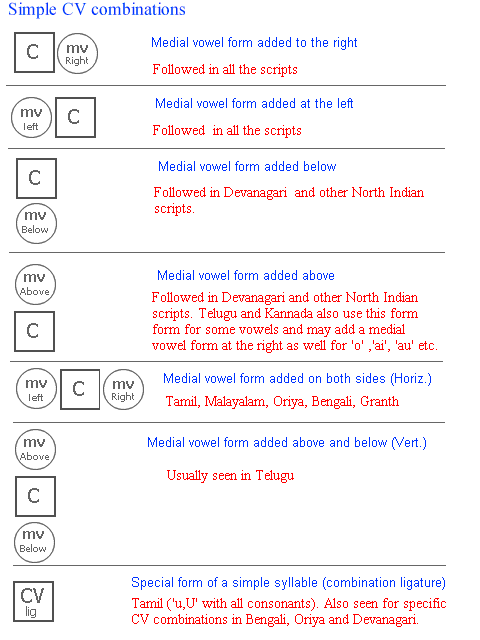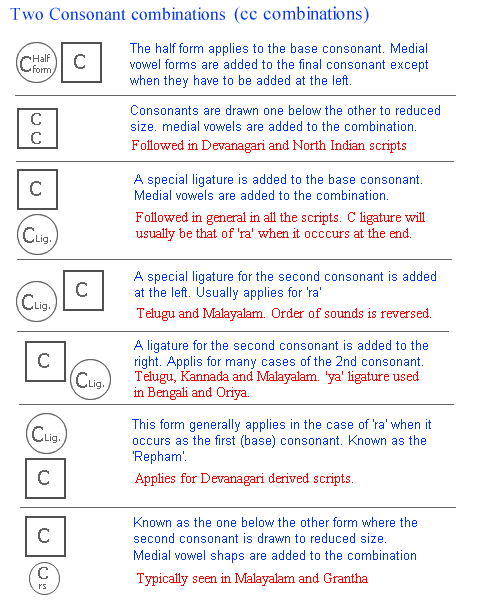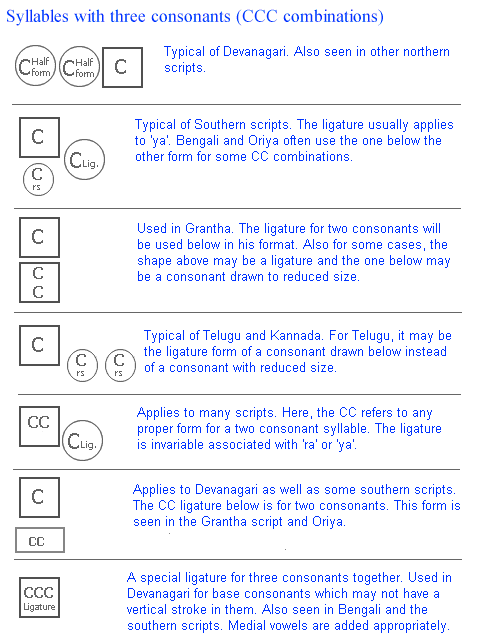Writing Systems followed in Indian languages
An understanding of the writing systems followed in India will be of help to those interested in Indian languages. Also, such understanding will be of considerable help in designing fonts for Indian scripts as well as develop applications which discuss the writing systems.Basically, the languages of India employ a syllabic writing method where a unique shape is used for each syllable. Such a shape is generally related to the basic shapes of the consonants in the syllable but over the centuries, conventions have come to be followed. These conventions differ across the scripts. It is the opinion of scholars that all the scripts in use have been derived from Brahmi, the script used during Emperor Ashoka's time (300 BCE). However, there are sufficient reasons to study the scripts individually since the variations will help us understand the problems involved in using computers to deal with the scripts.
The basic quantum for a syllable is a combination of one or more consonants and a vowel. A vowel or consonant by itself is also treated as a syllable. A syllable may be logically viewed as
V
C
CV
CCV
CCCV
CCCCV
CCC...VHere V represents a vowel and C a consonant. When a consonant by itself constitutes a syllable, it is assumed that it has 'a' as the vowel as part of the syllable. This representation corresponds to the phonetic description of the syllable in terms of the more basic sounds of the language.
When text is written, the phonetic representation above does not hold but a syllable is written following a set of rules specific to the writing system employed. These rules specify how a displayed syllable should be composed from more basic shapes. The basic shapes mentioned here are not just the shapes for the vowels and consonants as one might think but include many individual shapes that relate to combinations of sounds corresponding to the vowels and consonants.
A basic principle followed in a syllabic writing system is that one employs 'medial vowel shapes' for vowels which end the syllable. A medial vowel shape can never be shown by itself but must accompany the shape for a consonant or a sequence of consonants. However, the 'medial vowel' representation rule may itself be violated and special shapes used to represent specific combinations of a consonant and a vowel.
To understand the intricacies of the different writing systems, we provide a graphical illustration of the manner in which a syllable may be composed. Since there are many different ways of composing the shapes across the different scripts, it will be helpful to formulate representations for the elements that go into forming the shape for the syllable. In the illustration below, the elements in squares refer to shapes that are considered basic shapes in the writing system. These basic shapes constitute syllables themselves but the set will not be adequate to specify the full complement of syllables used in the language. It must be remembered that the writing systems do provide rules for writing arbitrary syllables but such rules will help mostly for syllables which are not native to the language. The elements in circles refer to shapes that get added to the more basic shapes (squares). The description provided against each shape (basic or added) will provide a clue to the rules in writing syllables.
In the discussion below, examples form different scripts will be used to illustrate the composition rules. Simple CV combinations are examined first. These correspond to simple syllables. Yet there many different ways in which the syllable is written in practice. The variations are largely across the scripts but for any one script, the location of the medial vowel will depend on the vowel. For the same medial vowel, the medial vowel location as well as representation is script dependent. Even for this very simple case, ligature forms exist in almost all the scripts. In Tamil, the CV combinations involving the short as well s long 'u' utilize ligatures. In Devanagari 'ru' and 'ruu' have ligatures.

Return to TopThe illustration below shows the different formats for a syllable involving two consonants and a vowel. Ligature based forms are more frequent for this case though the basic rule of half forms or one below the other forms apply in general. The medial vowel form is usually attached to the basic consonant or in some cases, a consonant-consonant ligature. Medial vowels added to the left get added before the half form shapes. In Telugu and Kannada, ligatures are used for some consonants which appear below. In general, one may not be able to discern the ordering of the sounds associated with the syllable unless one knows the conventions. In most scripts. CC ligatures are quite common and in some cases, the ligatures may give no clues to the consonants they represent. It will therefore be necessary to memorize the ligatures typically for about 15-30 cases. It also happens that the shapes for the ligatures differ to such an extent as to require additional medial vowel shapes for proper alignment.

Return to Top
Syllables with three consonantsSyllables with three consonants (CCC form). Three consonants or more in a syllable is not unusual though they may account for only about 10% of the syllables in the language. Half forms are used to advantage in Devanagari. The once below the other form gets extended to three consonants in the case of Grantha. When three consonants are involved, ligatures are common when the last consonant is an 'r' or 'y'. In Devanagari, syllables with 'da' often have ligature forms. In the Grantha, three consonants written one below the other are not uncommon. When rendered this way, the spacing between lines will increase and so fewer lines get accommodated in a page.

Return to TopExamples of Syllables from different scripts
Illustrated below are examples of syllables from different scripts which conform to the rules indicated above. It must be noted that these are written according the standard conventions followed. Telugu, Kannada and Grantha require a number of ligatured consonants together with properly positioned medial vowels and this generally makes it difficult to create 8 bit fonts for these scripts. The specific syllables used in the illustrations are not identified here. The viewer may refer to the corresponding pages describing each script for details.

Using Generic Consonants to write syllablesShape generation for a syllable is well defined and standardized only for simple syllables made up of CV combinations. When new syllables have to be handled (typically from foreign words), one may face specific difficulties in writing the same, especially if the syllable has a number of consonants in it. In Indian languages which are based on the principle of root words, one normally does not see long syllables except in rare instances. The writing systems generally allow any syllable to be written in decomposed form by just concatenating the generic consonants and ending the syllable with a CV combination.
The flexibility (or freedom) to show syllables in alternate forms can lead to headaches when string processing is attempted. When alternate forms for a syllable are permitted, the internal representation should reflect the specific desired form (as is the case with Unicode). Algorithms to identify syllables get complicated on account of this.
Syllabic Writing systems employ individual shapes for each syllable. So thousands of shapes are needed in practice. However, most of these are derived from a much smaller set of basic shapes using the rules for composing a syllable.
The illustrations shown explain how syllables are composed in practice.
